Massachusetts is famous for its rich avifauna – there are over 500 bird species there with a number of those being very active during the night!
Examples of nocturnal birds in Massachusetts include the northern mockingbird, barred owl, common nighthawk, American woodcock, American robin, barn owl, and many others.
Do some of them sound familiar? Let’s jump in and see what each of these looks and sounds like!
Table of Contents
Night Birds In Massachusetts
1. American Woodcock

- Scientific Name: Scolopax minor
American woodcocks are elusive birds in Massachusetts, heard singing during dawn and dusk for around 45 minutes after sunset and before sunrise. Look in fields next to forests, especially near powerline cuts.
They’re hard to spot due to their nocturnal habits and inconspicuous appearance. Listen for their “peent” call on the ground or twittering in the air.
American Woodcock Call | Source: Jonathon Jongsma, CC BY-SA 3.0, via Wikimedia Commons
2. Wilson’s Snipe
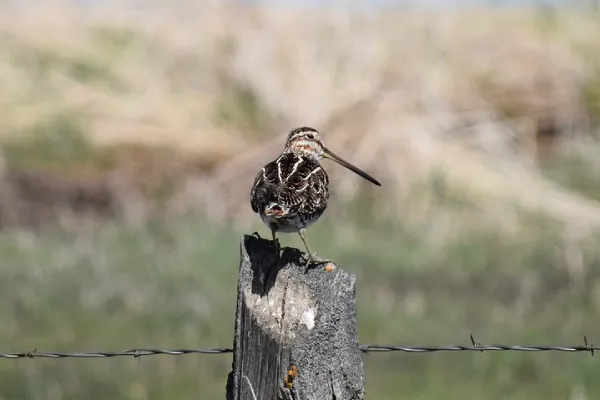
- Scientific Name: Gallinago delicata
Like American woodcocks, Wilson’s snipes are found in wet fields, sedge marshes, and bogs during the summer in Massachusetts. They’re most active during dawn and dusk.
To locate them, listen for the “tuk-tuk” call from the ground or low perches. Their winnowing display flight is unique and can be heard overhead.
Wilson’s Snipe Call | Source: Doug Hynes, CC BY-SA 4.0, via Wikimedia Commons
Males perform high-circling flights and shallow dives, creating distinctive sounds during both day and night.
3. Eastern Screech-Owl

- Scientific Name: Megascops asio
Eastern screech owls are small, stocky owls with big heads, large yellow eyes, and horn-colored beaks. They’re the most strictly nocturnal North American owls.
In Massachusetts, they’re permanent residents, usually in woodlands near water and at lower elevations.
They’re most vocal near sunset and quieter as the night goes on. Listen for “whinny” and trilling tremolo calls. Around full moons and before storms, calls are more frequent.
Eastern Screech-owl Call | Source: Jonathon Jongsma, CC BY-SA 3.0, via Wikimedia Commons
In June-August, you might hear juvenile hissing sounds.
4. Great Horned Owl

- Scientific Name: Bubo virginianus
Great horned owls are one of the biggest birds that sing at night in Massachusetts. They measure almost 2 feet long, weigh up to 3.5 pounds, and become most vocal for an hour after dark and an hour before dawn.
These owls can be found throughout the year in the state and prefer open areas like fields and marshes near mature forests.
Great Horned Owl Call | Source: Michael & Katie LaTour, CC BY-SA 4.0, via Wikimedia Commons
In winter or spring, they often sing in a duet. In summer, the distinctive juvenile begging call can sometimes be confused with the calls of the rare barn owl.
5. Barn Owl
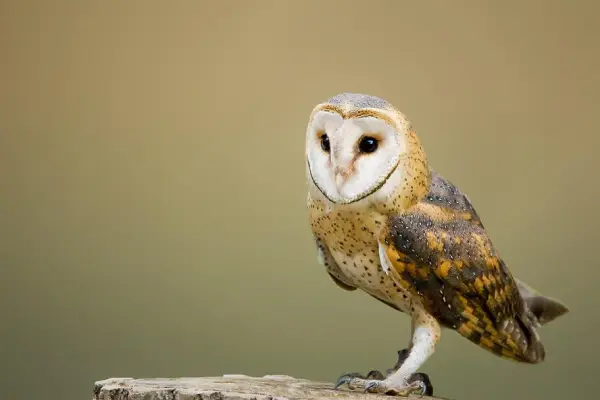
- Scientific Name: Tyto alba
Barn owls have seen a concerning decline over the past two decades. They are highly elusive and listed as a Species of Special Concern in the state.
If you live along the coastal plain from Newburyport to Cape Cod and surrounding islands, you are most likely to hear their bone-chilling screams at night. There have been also occasional sightings in the Connecticut and Housatonic River Valleys.
Barn Owl Call | Source: Luis Gracia, CC BY-SA 4.0, via Wikimedia Commons
These medium-sized owls do not hoot and have a distinctive “ghostly” appearance with their heart-shaped heads, cinnamon and gray upperparts, and white underparts. They nest in existing cavities and breed in open habitats like grasslands, marshes, and agricultural areas.
Read More: What birds sing at night in Virginia?
6. Barred Owl
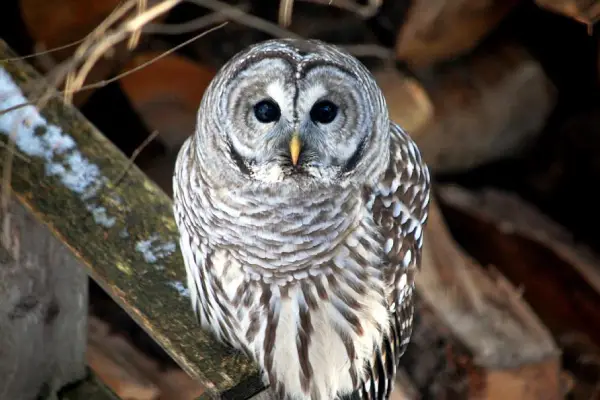
- Scientific Name: Strix varia
Barred owls are year-round residents of Massachusetts, common in dense deciduous or mixed forests, particularly near water.
Found in most of Massachusetts other than the southeast, these owls are active throughout the night when they emit their “who-cooks-for-you” song and “hoo-ahhh” call. They will duet, and their juveniles make a high-pitched raspy hissing noise, an automatic confirmation if it’s heard in a specific block.
Barred Owl Song | Source: Jonathon Jongsma, CC BY-SA 4.0, via Wikimedia Commons
7. Long-eared Owl
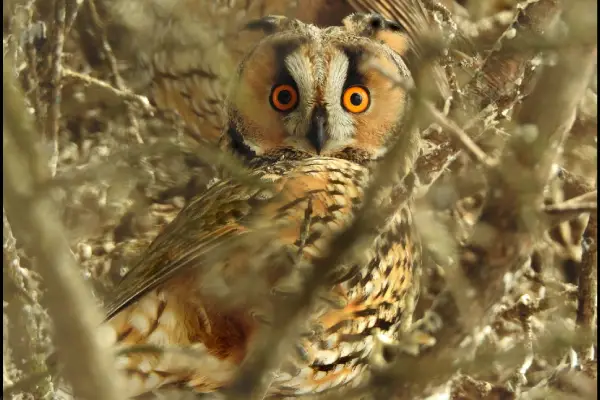
- Scientific Name: Asio otus
Long-eared owls are elusive birds that can be found in open forests, marshy areas, and dense coniferous woods. These secretive, nocturnal, and well-camouflaged owls have gray-brown bodies with pale bars and heavy streaks on their underparts.
They become active shortly after dusk throughout the night. Long-eared owls don’t vocalize often but have distinct calls. The male’s song is a low-pitched series of “hoo” notes, similar to the sound of blowing across a bottle.
Long-eared Owl Call | Source: Alexander Kurthy, CC BY-SA 4.0, via Wikimedia Commons
The distinctive juvenile begging call is also a good indicator, but caution is needed as distant barking dogs or mooing cows can sound like long-eared owls.
Read More: What are some examples of night birds found in Michigan?
8. Short-eared Owl

- Scientific Name: Asio flammeus
Short-eared owls are found on all continents except Antarctica and Australia, making them one of the most widespread bird species.
Massachusetts has 20 to 25 breeding pairs of Short-eared owls, and only three other Northeastern states (New York, Pennsylvania, Vermont) also have breeding populations, albeit in even smaller numbers.
These nocturnal owls live in large, undeveloped coastal grassland and heathland areas, which are nearly as endangered as the owls themselves. Notice their large yellow eyes that are accentuated by black rings, making them look like they are wearing mascara!
Although mostly silent, short-eared owls will make a series of “voo-hoo-hoo” calls.
Short-eared Owl Call | Source: Jamescandless, CC BY-SA 3.0, via Wikimedia Commons
They are generally nocturnal when most of the hunting happens, but they can also be crepuscular (active near dawn and dusk) and even diurnal (to a much lesser extent).
9. Northern Saw-whet Owl

- Scientific Name: Aegolius acadicus
Northern saw-whet owls are year-round residents in Massachusetts. They have mottled brown feathers with white spots, yellow eyes, and no ear tufts. Their flight feathers glow pink under UV light due to a pigment called porphyrin.
These owls are known for their loud, repetitive whistles that sound like a saw being sharpened. Listen for the male’s tooting advertising song, which goes “toot-toot-toot.” They also make other calls, and young owls produce a raspy, hissing sound.
You can hear them most actively about 2 hours after sunset, with their calling decreasing just before sunrise.
Read More: What birds can you hear at night in Indiana?
10. Pied-billed Grebe

- Scientific Name: Podilymbus podiceps
Pied-billed grebes, small and stocky water birds, can be heard in Massachusetts during mid-winter. They have brown plumage that’s darker on the crown and back, making them hard to spot due to great camouflage.
You’ll find them in marshes and ponds with emergent vegetation, and they’re active throughout the night. Listen for their loud, whooping, cuckoo-like song, often in duets with pairs singing together.
Read More: Nocturnal birds of NC
11. Common Nighthawk

- Scientific Name: Chordeiles minor
Common nighthawks, medium-sized birds with forked tails and long, pointed wings, are most often heard and seen in Massachusetts during their southern migration when they pass overhead in loose flocks along river valleys in the last days of August.
They’re found in prairies, forests, savannahs, and urban areas. Listen for their “peent” sound and watch for their courtship displays with rapid dives creating a booming sound.
Common Nighthawk Call | Source: Unknown author, Public domain, via Wikimedia Commons
Nighthawks are well-camouflaged during the day, with gray, black, and brown plumage and with white wing patches near the base of primary feathers.
12. Eastern Whip-poor-will
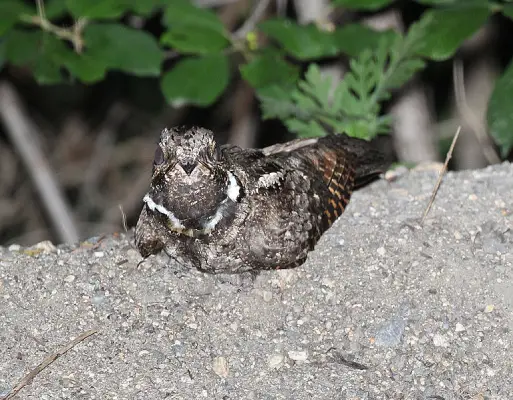
- Scientific Name: Antrostomus vociferus
Eastern whip-poor-wills in Massachusetts are seen during the breeding season. They have mottled plumage that blends in with their surroundings.
These cryptic, nocturnal birds are hard to spot during the day. You can find them near pine barrens and forest openings, where they sing their distinctive “whip-poor-will” song at night.
Whip-poor-wills are often confused with common nighthawks but can be distinguished by their behavior and unique call.
Eastern whip-poor-will Call | Source: G. McGrane, Public domain, via Wikimedia Commons
They are also active at night in South Carolina; read about other night birds found there in this article.
13. Virginia Rail

- Scientific Name: Rallus limicola
Virginia rails are aquatic birds you can hear at night in Massachusetts in various counties, particularly Berkshire, Worcester, Middlesex, and Essex.
You can hear them around wetlands with cattails at any time of day or night, making harsh “kuk-kuk-kuk” calls, as well as “grunt” calls for communication.
They are often found together with soras; short-billed soras feed on seeds, while the long-billed Virginia rails mostly consume insects.
Read More: List of common night birds in Florida
14. Sora

- Scientific Name: Porzana carolina
Soras are small waterbirds found in Massachusetts during the summer. They have short yellow beaks, dark-marked brown upperparts, blue-gray faces and underparts, and black and white markings on the flanks.
You can spot them around wetlands with cattails and open water. They use a descending “whinny” call for communication within mated pairs and territorial claims. Additionally, they have a “ker-wee” call to attract mates and can be mostly heard during dawn and dusk.
Sora Call | Source: Jonathon Jongsma, CC BY-SA 3.0, via Wikimedia Commons
Read More: What are some birds singing at night in Georgia?
15. Clapper Rail

- Scientific Name: Rallus crepitans
Clapper rails are large brown birds found along the Atlantic coasts of the eastern United States, eastern Mexico, and some Caribbean islands. These chicken-sized birds rarely fly and have grayish-brown plumage with orange bills that curve downwards.
These birds inhabit saltmarshes, and you can listen to the male’s repeated “kek” calls. They also have grunt or “clapper” calls that pairs use to communicate.
Clapper Rail Call
Clapper rails have 4-16 creamy white eggs with brownish blotches that both parents incubate; males will incubate them at night.
Read More: What birds chirp at night in Texas?
16. Common Gallinule

- Scientific Name: Gallinula galeata
Common gallinules are medium-sized marsh birds found throughout Massachusetts except for Martha’s Vineyard. They have dark plumage with white undertails and red frontal plates on their heads.
You’ll spot them in freshwater wetlands with open water and vegetation. Listen for their “marsh chicken sound” and “clucks” as these are their most frequent calls.
These birds are mainly active at dawn, with some activity at dusk.
Read More: Examples of nocturnal birds heard in Louisiana
17. American Coot
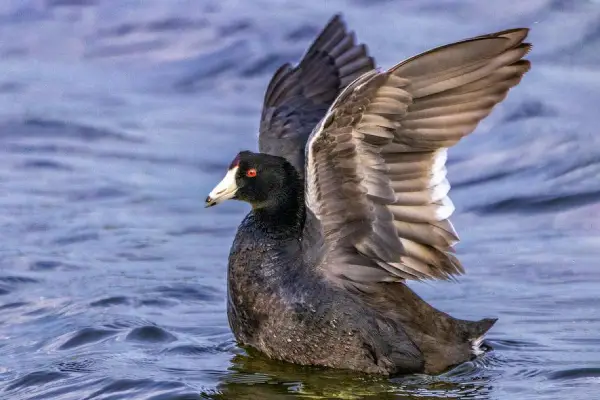
- Scientific Name: Fulica americana
American coots are often heard and seen in Massachusetts during fall migration, usually in large groups feeding on aquatic vegetation. They are small waterbirds resembling chickens that breed primarily in the western and southern parts of the state.
Found in freshwater wetlands with open water and vegetation, they make a sharp “poot” call and a screeching “kree” sound. They are noisy swimmers, often recognized by splashing water sounds.
Coots are most active around dawn and dusk, and although they resemble ducks, they are only distantly related to them.
Further Reading: List of commonly heard night birds in Alabama
18. Black-crowned Night Heron
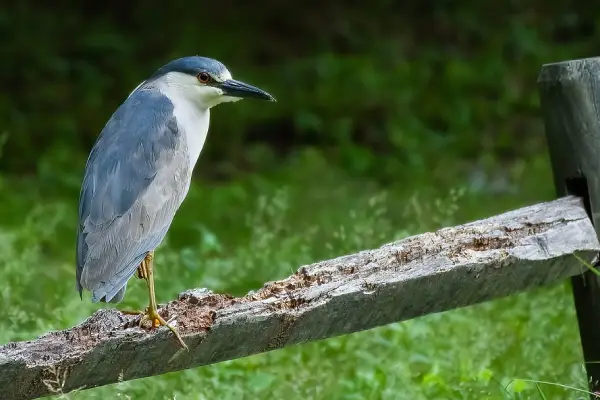
- Scientific Name: Nycticorax nycticorax
Black-crowned night-herons are distributed along the Massachusetts coast, frequently around wooded swamps, ponds, lakes, and mangroves.
Unlike most herons, they are most active at night or at dusk. They often bait fish by tossing food in the water to lure prey before striking with their long beaks.
These nocturnal and noisy herons migrate in large night flocks. Their scientific name “Nycticorax” comes from the ancient Greek term meaning “night raven,” referring to their nocturnal feeding habits and crow-like calls.
Black-crowned Night Heron Call | Source: Jonathon Jongsma, CC BY-SA 3.0, via Wikimedia Commons
Read More: Examples of birds heard at night in Oregon
19. Northern Mockingbird
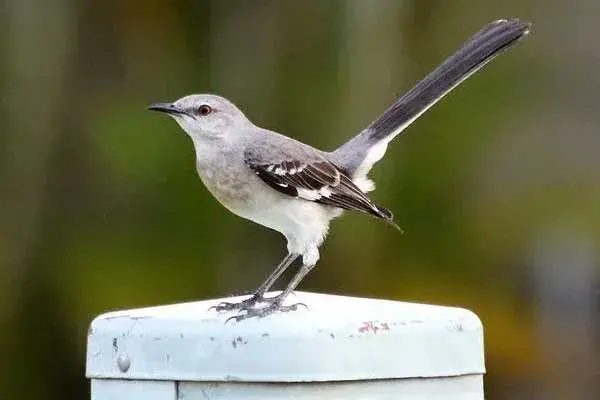
- Scientific name: Mimus polyglottos
Northern mockingbirds are commonly heard at night in Massachusetts, with the nighttime singers often being young, unattached males or older males without mates.
To reduce their constant singing, you can use bird nets on trees or set up cardboard cutouts of predators like hawks or owls.
These birds are year-round residents in the state, and their translated Latin name, “many-tongued mimic,” is well-deserved. They can imitate over 35 species and learn more than 200 songs in their lifetime!
Their mimicry extends to sounds like rusty hinges, car alarms, cackling hens, and dog barks, often indistinguishable from the real thing.
Northern Mockingbird Call | Source: Sandtouch Limited Company, a Texas limited liability company, CC BY 3.0, via Wikimedia Commons
Read More: What birds sing during the night in Oklahoma?
20. American Robin

- Scientific name: Turdus migratorius
American robins, common songbirds in Massachusetts year-round, are often found in forests, lawns, and suburbs across the state.
As winter turns to spring and daylight grows, they earn the nickname “wake robins” for being among the first birds heard at dawn. Their song is a “cheery” carol, a series of clear whistles, along with a sharp “yeep” alarm call and a mumbled “tuk” for communication.
American Robin Song | Source: G. McGrane, Public domain, via Wikimedia Commons
At sunset, their song shifts, adding soft, almost whispered notes, creating an elegant and intricate evening melody.
What Birds Sing At Night In Massachusetts?
The most common birds that sing at night in Massachusetts are Northern mockingbirds.
Mockingbirds singing all night are often young, unattached males or older males without a mate. In case you want to stop their nighttime singing, try to cover your tree with bird netting or add an owl/hawk cardboard cutout to scare them away.
You might have also heard American robins and their cheery carol or even barn owls and their bone-chilling screams.
Read More: What birds sing at night in Tennessee?
Summary
Massachusetts’ rich avifauna is brimming with nocturnal birds. Some can be seen year-round there, like several owl species and northern mockingbirds, while others, like common nighthawks, American woodcocks, and Wilson’s snipes visit the state only to breed.
In case you’ve stumbled upon or heard any of these birds, we hope this guide helped you identify which ones they were.
Feel free to read our other popular articles on birds chirping at night in Ohio and birds chirping at night in Pennsylvania